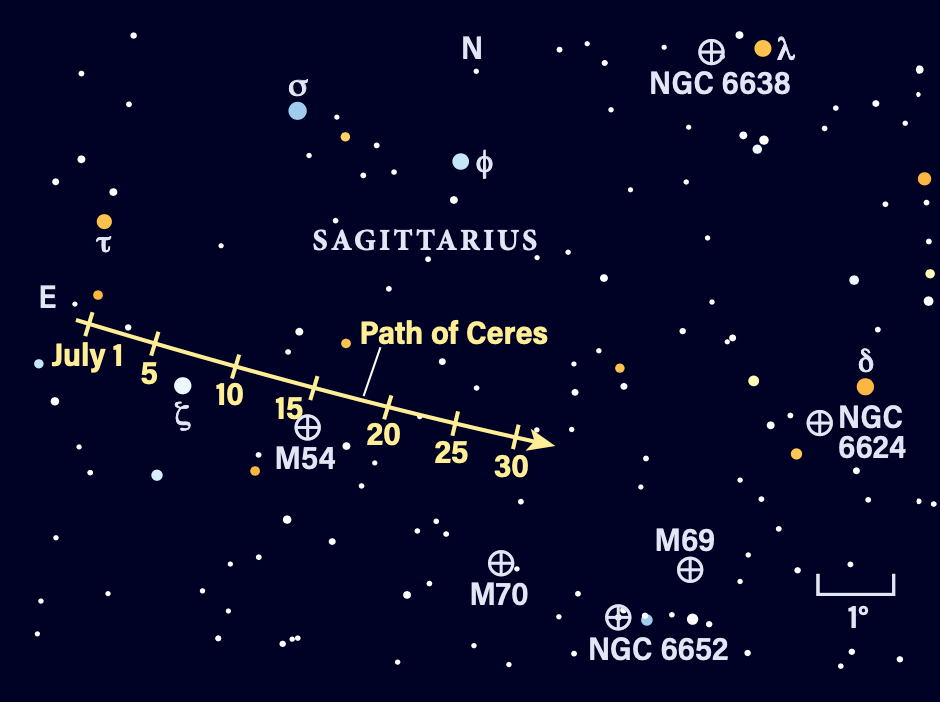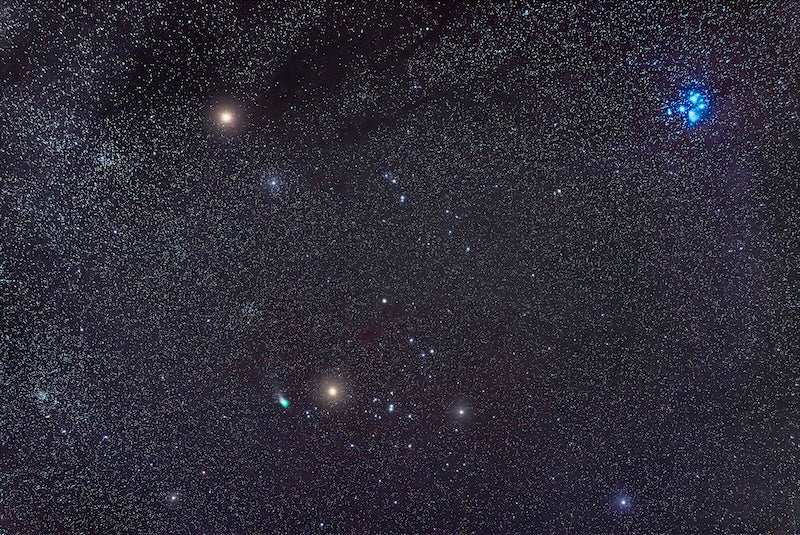
The planets are spreading out this month. Mercury and Venus lie in the evening sky; after midnight the next set of planets rises one after the other, led by Saturn. It’s followed into the early-morning sky by Neptune, Mars, Uranus, and Jupiter. Saturn in particular is stunning, with the rings at their narrowest for the year.
First to set after the Sun on July 1 is Venus. It’s a challenging object to find, disappearing within 30 minutes of sunset. If you have a very clear western horizon, look for the magnitude –3.9 planet in bright twilight, standing only 2° high 15 minutes after sunset.
Try again on July 6, when the crescent Moon appears 7° high about 20 minutes after sunset. Venus lies 5° below it and once again sets quickly.
By the end of July, Venus is nearly 16° east of the Sun but still hugs the horizon from northern temperate latitudes. It stands 3° high 30 minutes after sunset, and those scanning the horizon with binoculars might spot 1st-magnitude Regulus, Leo’s brightest star, 5° east of the planet. Mercury is also present, at the same altitude as Venus and 4.7° south of Regulus, shining at magnitude 0.9.
Rewinding a bit, Mercury shines in the evening sky at magnitude –0.6 on July 1. A healthy 18.5° from the Sun, it remains 7° high 30 minutes after sunset. As the sky darkens, Mercury will be an easy object to catch. Watch for Castor and Pollux, Gemini’s pair of 1st-magnitude stars, which stand at the same altitude above the horizon northwest of Mercury.
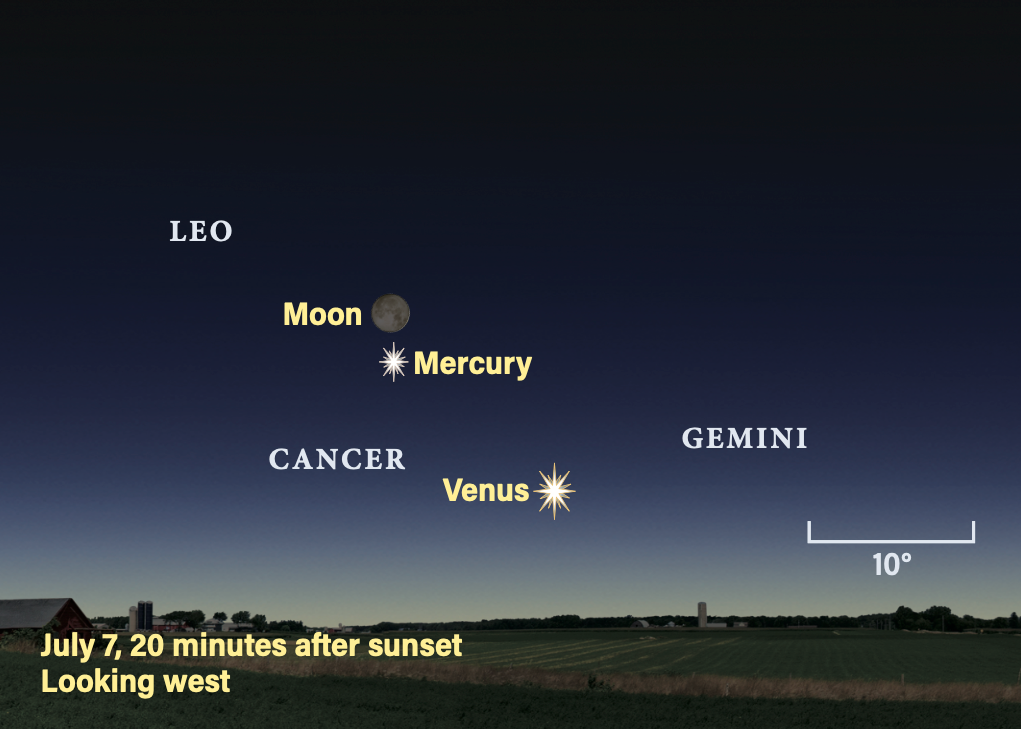
Mercury slides away from the pair of stars quickly and by July 7, the waxing Moon stands 3° above Mercury — a beautiful sight in twilight. Look for earthshine illuminating the dark hemisphere of the Moon.
Mercury fades as it increases its distance from the Sun and reaches its greatest eastern elongation of 27° on July 22. It has now dimmed to magnitude 0.5 and stands within 3° of Regulus. The planet has become more challenging to find. Mercury stands 5° high 40 minutes after sunset, a good time to spot it.
Due to the low angle of the ecliptic to the horizon in the Northern Hemisphere, this isn’t as favorable as elongations that occur in March. Southern Hemisphere observers will have a better view.
Saturn rises at midnight on July 1, located in northeastern Aquarius just 2.1° from Phi (ϕ) Aquarii. It’s easy to spot at magnitude 0.9. The ringed world barely moves at first, then slowly progresses along its retrograde path and ends the month within 1.5° of Phi.
On July 24, a waxing gibbous Moon stands about 7° west of Saturn. Later in the day for regions in Africa, Asia, and Indonesia, the Moon occults Saturn. The planet brightens to magnitude 0.7 by the end of July in preparation for September’s opposition.
The rings appear very fine and nearly edge-on through a telescope, tilted by only 2° to our line of sight. Its disk spans 18″ and the wide axis of the rings stretches roughly 41″ across. Through the end of the year, the rings will widen before closing again and appearing edge-on in March 2025.
Now that the ring plane is almost edge-on, Saturn’s satellites cross in front of or behind the planet. Titan, the brightest moon at magnitude 8.5, orbits every 16 days. The moon is occulted by Saturn July 8 around 2:40 a.m. EDT (not visible in the Pacific time zone). It takes several minutes to disappear, so begin watching 10 to 20 minutes earlier. A second occultation occurs July 24 around 1:30 a.m. EDT (not visible in Mountain or Pacific time zones).
On July 16, Titan begins a transit across Saturn just before 2:30 a.m. EDT (again, not visible on the West Coast). The transit lasts nearly four hours, with egress occurring around 4:20 a.m. MDT (in daylight for the East Coast and nearly sunrise in the Midwest).
The transit starting July 31/Aug. 1 at 1:15 a.m. EDT is the first easily seen from the Mountain time zone, although Saturn is at an elevation of only 13°.
Dione begins a transit an hour later, led by its shadow, which appears behind Titan on the cloud tops — an extraordinary alignment. Dione is a small moon that shines at 10th magnitude, so it’s difficult to see against the bright background of Saturn. It’s easier to capture using high-speed video and image-refining techniques.
Several moons also skim the edge of the rings as seen from Earth, although these are also difficult to observe. Again, high-resolution imaging can catch these events.
Iapetus orbits at a much greater distance from Saturn every 79 days. It moves 1′ north of Saturn on July 6, reaching inferior conjunction as it heads toward western elongation on the 27th. Between early July and this date, Iapetus brightens from about 11th magnitude to magnitude 10.2.
Neptune is in southwestern Pisces, some 5° southeast of Lambda (λ) Piscium in the Circlet. It rises around midnight and reaches a good height in the eastern sky by 2 a.m. local daylight time. As you scan with binoculars, look for a parallelogram of 4th- to 5th-magnitude stars. The northernmost bright one is 29 Psc; much dimmer Neptune lies nearly 2° to its north. Neptune shines at magnitude 7.7.
On July 25, the waning gibbous Moon stands about 4.5° southwest of Neptune two hours after rising. By dawn they’re less than 3° apart. Neptune reaches its stationary point early in July and the planet barely moves all month.
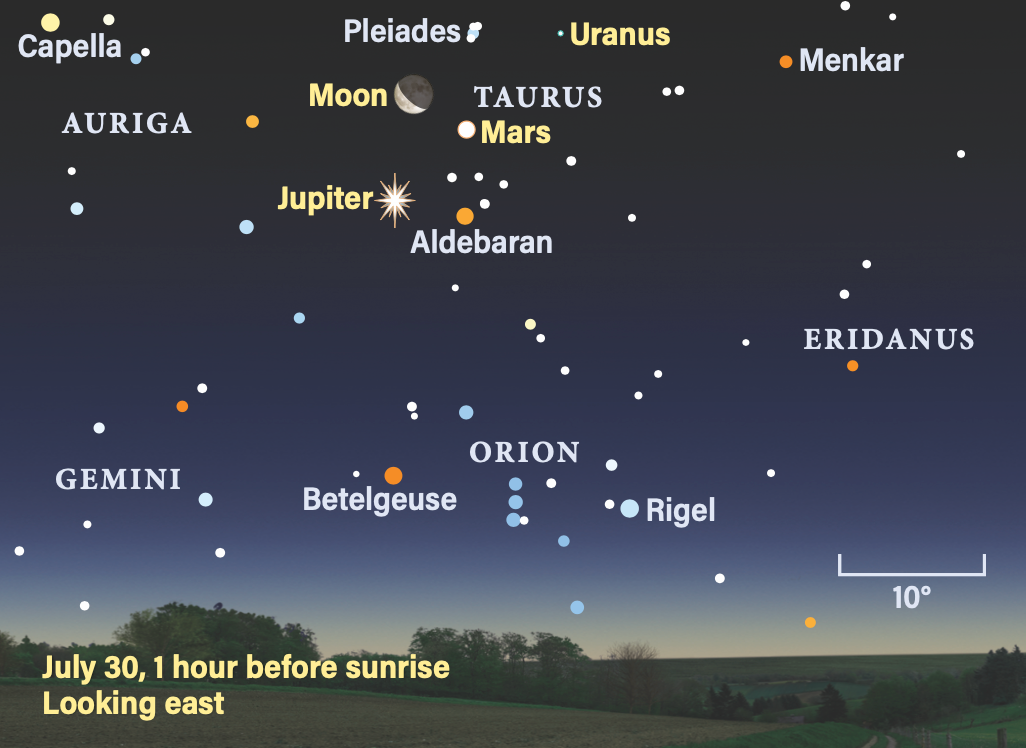
The next planet up is Mars, rising just after 2 a.m. local daylight time on July 1 with a waning crescent Moon. The Red Planet shines at magnitude 1 in southeastern Aries, 15° from the Pleiades (M45). Mars moves into Taurus by July 12.
Mars is closing in on Uranus, also in western Taurus, and they’re just over 2° apart on the 12th. Look again on July 15, when Mars and Uranus stand only 0.6° apart. Binoculars will reveal the dim, greenish-blue-hued disk of Uranus due north of Mars. Uranus shines at magnitude 5.8. The pair now stand 6° southwest of the Pleiades. Check each consecutive night as Mars pulls away from Uranus, moving about 0.7° east per day.
On July 20, Mars stands 4.8° due south of M45. By the 22nd, it’s brightened to magnitude 0.9. Mars continues eastward and at the end of July stands 5.5° northwest of Aldebaran, matching the star in magnitude. For a time, Taurus the Bull appears to have two eyes. A waning crescent Moon joins Mars a day earlier, on July 30. Along with M45 and Jupiter, also in Taurus, the view is spectacular.
Through a telescope, Mars is a challenging 6″ across and stands 30° high in the east as twilight begins on July 31.
Uranus remains near the western edge of Taurus all month. Its disk spans only 3″ through a telescope, challenging to see unless conditions are excellent. Once Mars has left the scene, you can spot Uranus in binoculars 2° west of a pair of 6th-magnitude stars, 13 and 14 Tauri, which are less than 0.4° apart and about 4.5° due south of the Pleiades.
Jupiter’s visibility improves each day as it climbs higher in the pre-dawn sky. The gas giant rises around 3:30 a.m. local daylight time on July 1, north of the Hyades star cluster in Taurus. A waning crescent Moon joins it July 3. By the 13th, Jupiter stands 5° due north of Aldebaran. The crescent Moon again joins Jupiter July 30 and 31. The planet starts the month at magnitude –2 and brightens by 0.1 magnitude by July 31, now rising before 2 a.m.
Through a telescope, Jupiter spans 35″ and is joined by the four Galilean moons, Io, Europa, Ganymede, and Callisto. Catching a transit or occultation is a great way to start a summer morning.
Early on July 4, Ganymede transits Jupiter’s south polar region. The event is underway as Jupiter rises in the western U.S. Ganymede slowly exits the disk around 5:50 a.m. MDT in twilight, while it’s still dark in the Pacific time zone.
Io and Europa put on a pair of events the morning of July 6. Europa’s transit begins at 4:42 a.m. EDT, visible from the eastern U.S. The moon’s shadow is already nearly done with a transit, approaching the western limb. As Jupiter rises farther west, Io’s shadow starts to transit at 5:15 a.m. CDT, as twilight encroaches on the Midwest. Observers in the western U.S. will see Io begin its transit at 5:02 a.m. MDT, with Europa exiting the disk minutes later, around 5:12 a.m. MDT.
Ganymede’s huge shadow crosses Jupiter’s south polar region July 11 between 4:52 a.m. and 6:40 a.m. MDT. (The exit occurs in daylight for the Mountain time zone but twilight in the Pacific time zone.) Europa’s shadow crosses the disk July 13, starting around 5:15 a.m. EDT, as Europa closes on Jupiter’s eastern limb and begins its own transit around 5:30 a.m. MDT.
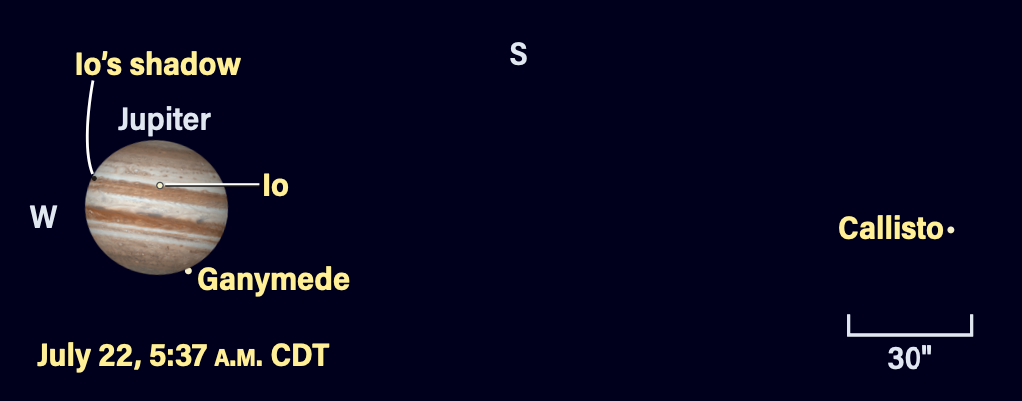
One of the most interesting events of the month is the transit of Io with its shadow as Ganymede reappears from eclipse on July 22. The first pair of events is better observed across the eastern half of the U.S. Io’s shadow begins a transit at 4:31 a.m. EDT (when Jupiter is only 10° high in the Midwest). Ganymede is occulted by Jupiter’s northwestern limb seven minutes later. Meanwhile, Io is approaching the eastern limb and begins to transit at 5:31 a.m. EDT. Ganymede passes behind Jupiter and reappears around 4:36 a.m. MDT, in bright twilight for the Midwest.
Another set of events occurs July 29. Ganymede enters Jupiter’s extended shadow west of the planet just before 4:40 a.m. EDT, followed by Europa just over an hour later, shortly before sunrise in the Eastern time zone. Then, Io’s shadow begins a transit at the eastern limb at 5:25 a.m. CDT. Within minutes, Ganymede exits the shadow still northwest of Jupiter at 5:28 a.m. CDT, a process that takes a few minutes. Watch it brighten as Io’s shadow moves onto the cloud tops. Io itself begins to transit around 5:30 a.m. MDT, now in bright twilight across the Mountain time zone but well seen in Pacific states.
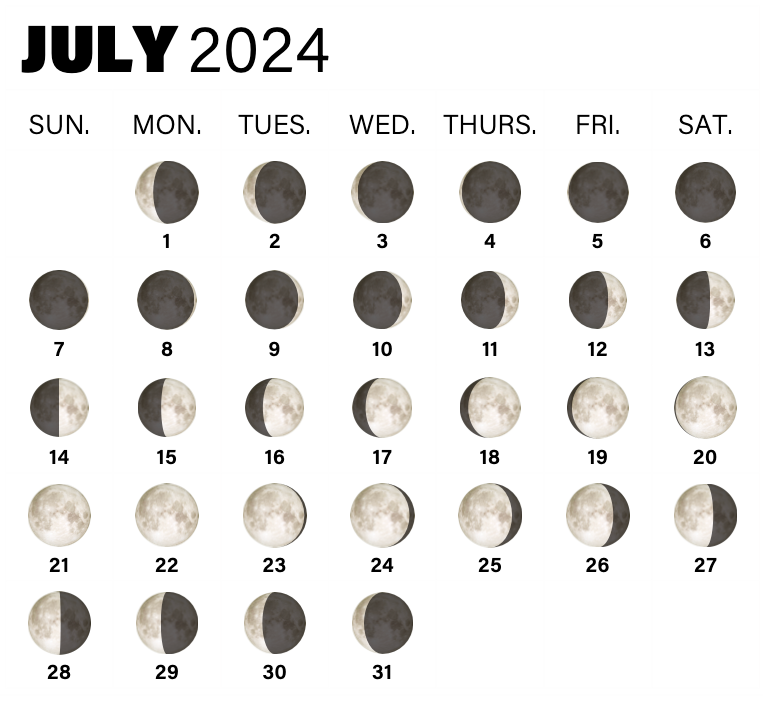
Rising Moon: Rack up the balls
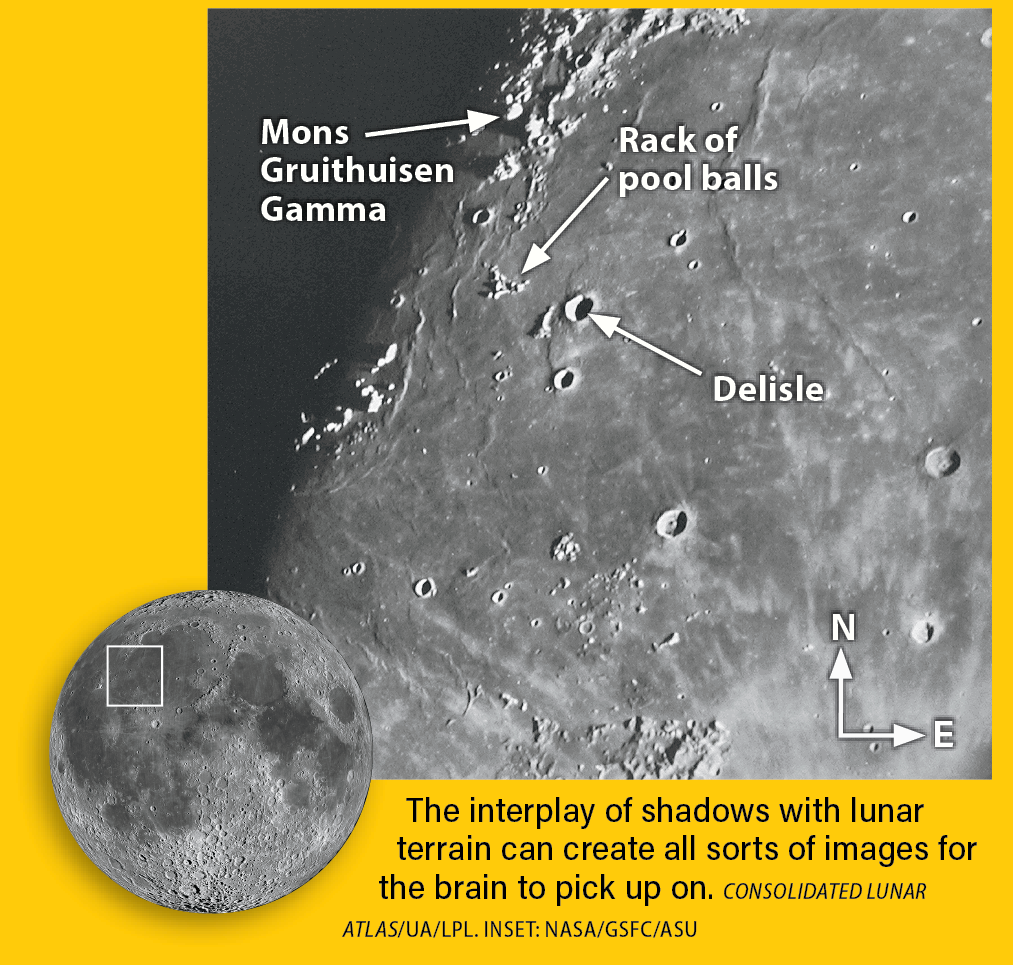
A lazy, hazy summer night is the perfect time to relax your scientific gaze and let your mind wander, your eyes meandering slowly along the day-night lunar zone we call the terminator. You may have seen the more famous Lunar X or V, examples of a clair-obscur effect — when the play of light and shadow bring to mind a letter, number, animal, face, or other object. But will you see a rack of pool balls July 16th, just west of the crater Delisle?
In reality, this is a clump of peaks left over from the giant impact that carved out Mare Imbrium, towering above the plains of lava that welled up afterward. Yet our earthbound brains crave familiarity in a foreign land. A couple of hours later, another region west of Mons Gruithuisen Gamma suggests an upturned sink or bathtub to some observers.
If this pareidolia tickles your fancy, do a search for “Moon clair-obscur lunarism” to find dozens of blogs and videos with dates and times that focus on these features. Mike Rowles has compiled a list of 99 such lunarisms — some you can see two nights in a row, others fleetingly for an hour or two. Relive that childhood enjoyment of seeing shapes in clouds.
Meteor Watch: A broad peak
July begins quietly on the meteor shower front, with rates increasing toward the end of the month as the early Perseids begin and the Southern Delta Aquariid shower reaches its peak. The latter is active from July 12 through Aug. 23 and peaks on July 31, although activity is fairly broad across a few days on either side of this date.
The radiant is near the star Skat in Aquarius, which reaches 30° elevation around 3 a.m. local daylight time, resulting in observed rates of about half the predicted zenithal hourly rate of 25 meteors per hour. The waning crescent Moon will have some effect on the visibility of fainter meteors.
The Southern Delta Aquariids are the result of Comet 96P/Machholz. This is 1 of 8 showers related to the comet, which has a 5.3-year orbital period.
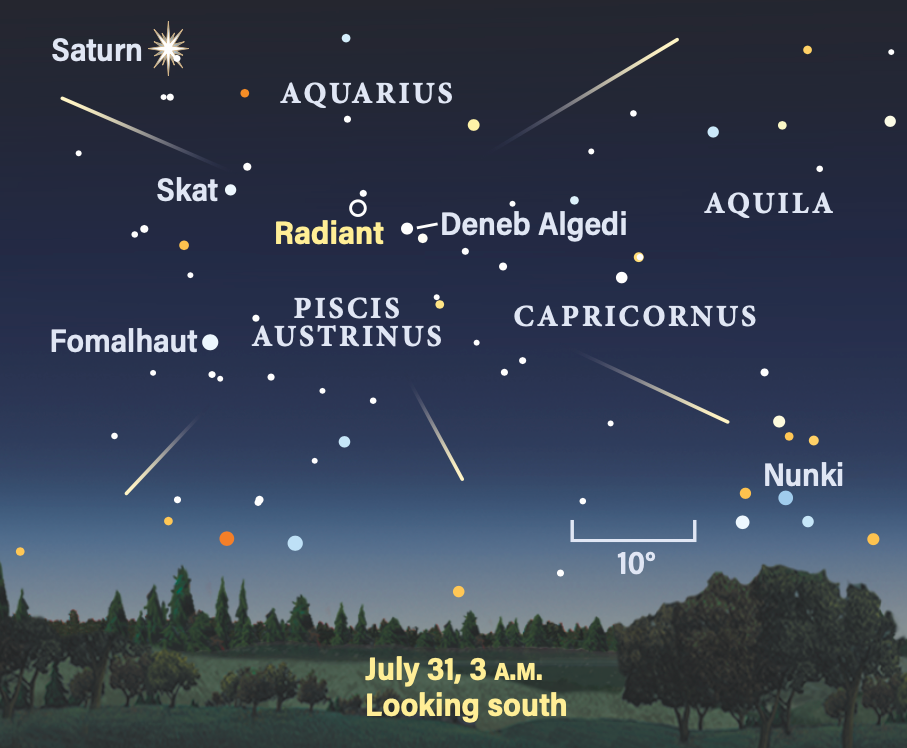
Comet Search: On your mark, get set, go!
The best two comets of the night are sinking below 15° altitude by sunset, so be on target as darkness arrives. Head straight south of Leo’s tail to get to C/2023 A3 (Tsuchinshan-ATLAS). On track to blow our socks off in October, it currently glows at a modest 8th magnitude and should sport a faint eastward tail if skies are dark and transparent enough. Approaching Mars’ orbit, the carbon atoms released with its dust are just turning on for imagers to catch a classic green coma. By the end of July, the comet is swallowed by twilight — see you in three months!
Quickly swing northwest to the feet of Ursa Major, where 13P/Olbers is traveling through Lynx and Leo Minor. It reached perihelion June 29 and will give us three more months of telescopic viewing. Binocular observers, challenge yourself to find the 8th-magnitude glow. Push the magnification past 100x and note that Olbers should be lopsided compared to spiral galaxy NGC 2841, some 9° to the north on July 8. Whose core is sharpest and brightest?
Need an overnight comet? Bring along a good chart to help you navigate the forest of 7th-magnitude stars between Cepheus and Draco to get to the challenging 10th-magnitude C/2021 S3 (PanSTARRS).
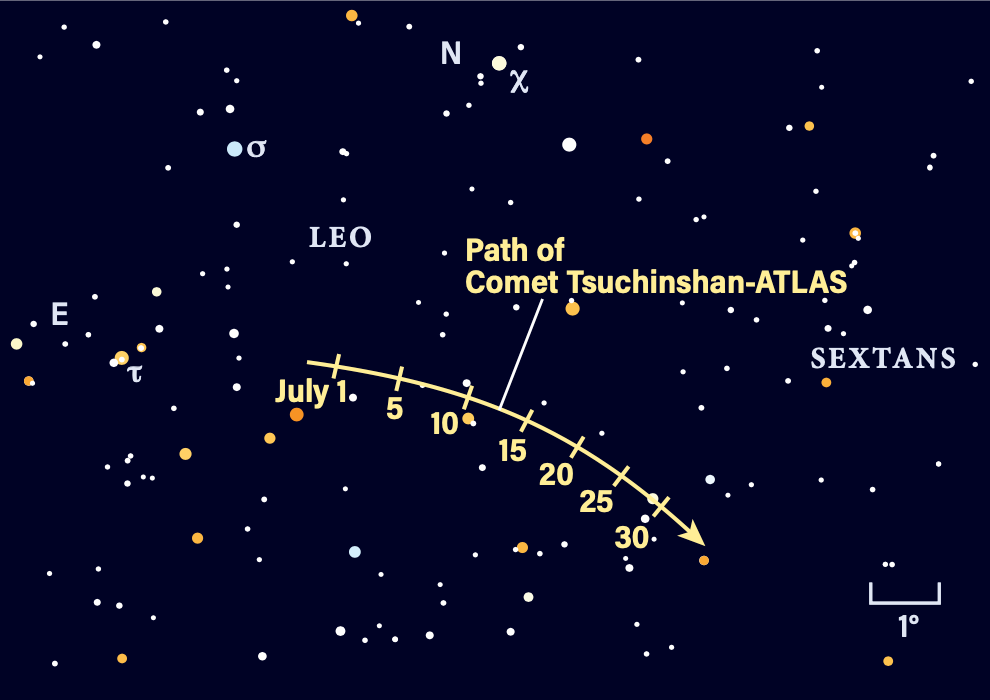
Locating Asteroids: Sweetening the (tea)pot
Within reach of binoculars from the suburbs, dwarf planet 1 Ceres gives us a nice and easy asteroid search this summer. Stargazers familiar with the heart of the galaxy know the collection of stars called the Teapot of Sagittarius. Magnitude 2.6 Zeta (ζ) Sagittarii anchors the base of the Teapot’s handle and will be our signpost to find Ceres.
The large dwarf planet (roughly 600 miles across) reflects the most sunlight at opposition on the 5th, raising it to magnitude 7.3 and leaving it largely uncontested in the eyepiece by the legions of fainter stars toward the galaxy’s hub. You can track its nightly shift against the background by penciling three or four stars onto a logbook sheet and returning an evening or two later to confirm the point that moved.
On the 20th, Ceres is sliding away from a trapezoid of stars (fainter than the limiting magnitude below); if you stay up late you might notice its tiny shift. For a laugh, can you see it on the 19th, a mere two lunar diameters south of the nearly Full Moon?
